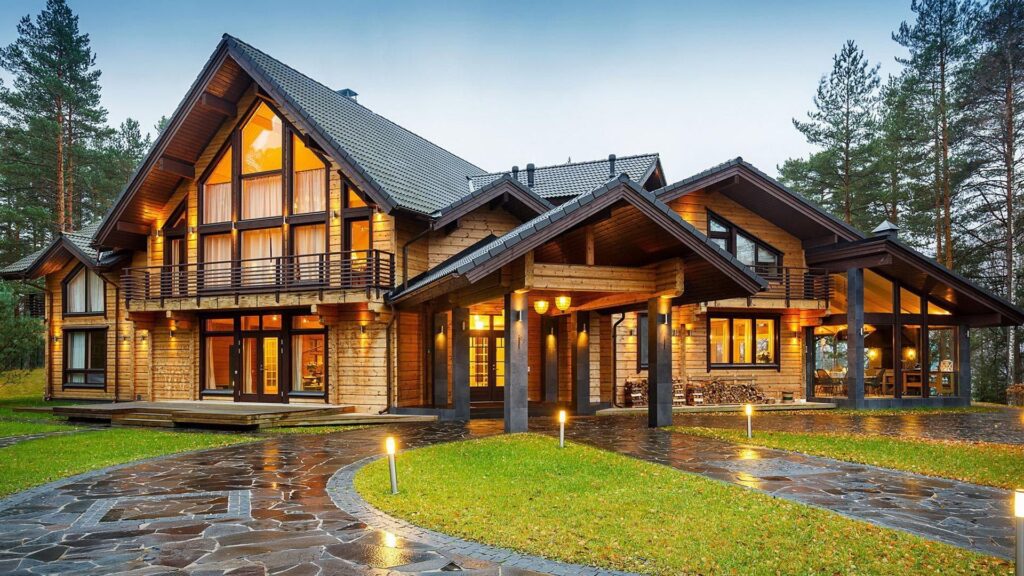
Wooden houses - brief descriptions and interior design
In ancient times, when people started to settle and build their first settlements, the main building material available to most was wood. Wooden houses have remained popular for many centuries, and today they are experiencing a new wave of popularity thanks to their eco-friendliness, natural appeal, and unique aesthetics.
Modern technologies allow building wooden houses of various types, adapting them to specific climate conditions, comfort requirements, and design preferences. Let’s consider several main types of wooden houses.
Log houses. This is the oldest type of wooden house, which is a construction made of whole or processed logs. Log houses have high thermal insulation and durability, as well as a unique rural charm.
Timber frame houses. Timber is processed wood in the form of rectangles. Such houses are easier and quicker to build, they have good thermal insulation and design versatility.
Timber frame houses. These are wooden houses with a wooden frame as their base. This type of house is characterized by fast construction and the ability to create non-standard architectural forms.
Profiled log houses. Profiled logs are a type of building material made from solid wood. This type of wooden house combines the advantages of log and timber frame houses.
It is important to note that the choice of a type of wooden house depends on many factors, including climate conditions, budget, design preferences, and others. But regardless of the choice, a wooden house will offer its inhabitants coziness, closeness to nature, and a unique atmosphere of warmth and harmony.
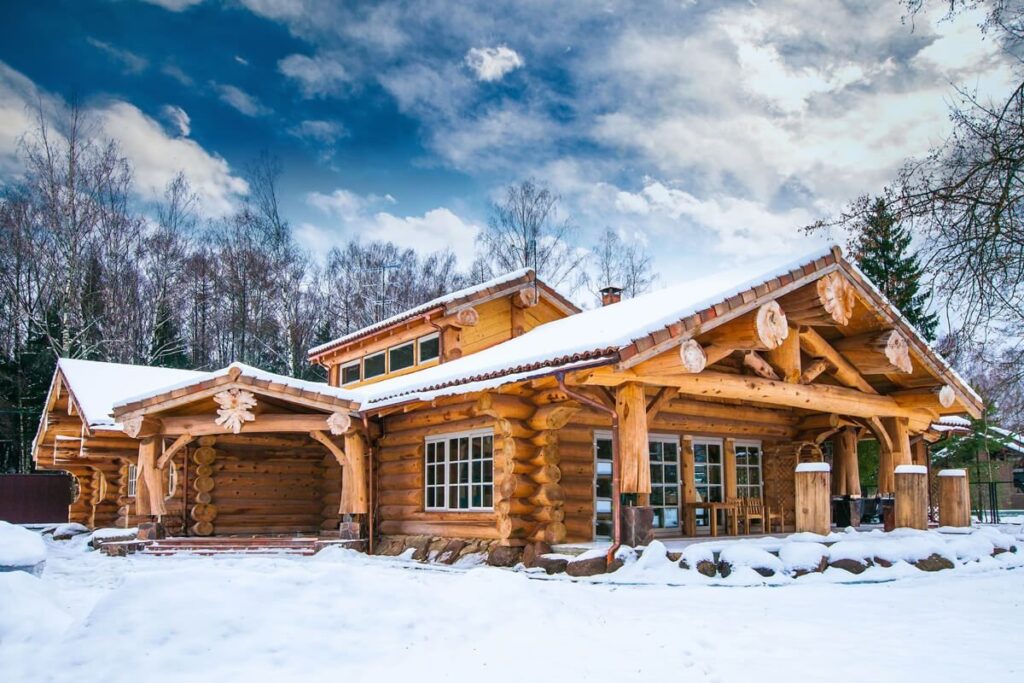
More about log houses:
Log houses are the oldest type of structures built from natural wood. Their construction mainly relies on the use of whole or split logs, which are laid horizontally and interconnected. The main technological process of building a log house includes several key stages:
Preparation of logs: This involves cleaning and treating the wood to withstand the impact of the environment and pests.
Foundation construction: Log houses are usually built on a concrete or stone foundation to provide stability and durability to the structure.
Wall assembly: Logs are laid horizontally and connected with special “locks” or “spikes” to create a stable and insulated wall.
Roofing: The roof can be made from various materials depending on the climate conditions and architectural preferences.
Now let’s move on to the pros and cons of log houses.
Pros:
Natural appeal: Log houses are built from natural wood, creating a healthy and eco-friendly atmosphere inside the house.
Thermal insulation: Logs retain heat well, providing comfortable living in cold weather.
Durability: With proper treatment and maintenance, a log house can last for decades.
Cons:
Cost: Building a log house can be quite expensive due to the cost of high-quality wood and the labor-intensive construction process.
Settling: Logs have a tendency to settle over time, which can lead to the appearance of cracks and the need for additional repairs.
Maintenance requirements: Wooden houses require regular care, including protection against pests and moisture.
Fire resistance: Wood is a flammable material, so fire safety measures are essential in log houses.
Overall, choosing a log house means opting for eco-friendliness, natural appeal, and a unique atmosphere, but it requires investing time and resources in its creation and maintenance.
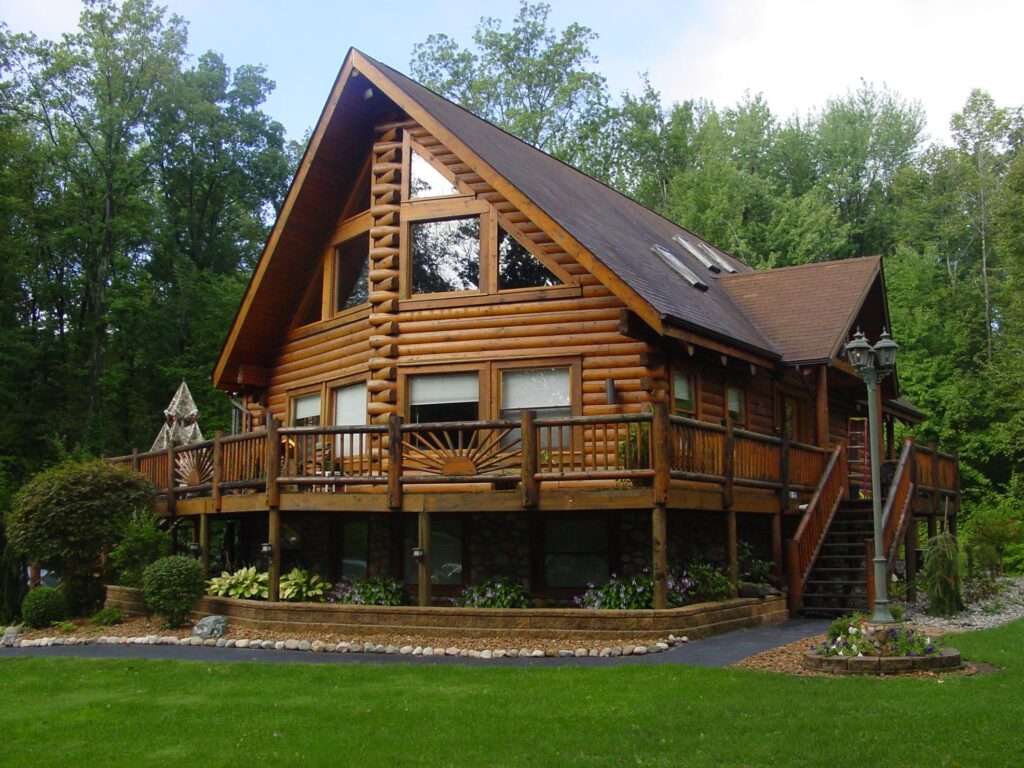
Houses made of timber - price/quality among wooden houses
Houses made of timber are one of the most popular options for wooden house construction. Timber is a material obtained by planing a wooden log, resulting in a smooth and even surface. In house construction, regular (unprocessed), profiled, or glued timbers are used. The construction process includes the following main stages:
Timber preparation: Wood is treated to protect it from pests and decay, followed by planing and profiling.
Foundation construction: Similar to log houses, the construction begins with creating a reliable foundation.
Wall assembly: Timbers are laid in walls using a special technique to ensure tight connections and heat preservation.
Roofing: After completing the wall works, the roof is installed.
Now let’s consider the advantages and disadvantages of timber houses compared to other types of wooden houses.
Pros:
Construction time: Thanks to the pre-processing and standardized dimensions of timber, houses made of timber are built faster than log houses.
Heat retention: Timber has good thermal insulation properties, and its improved geometry reduces the number of “cold bridges.”
Price: The cost of building a timber house is usually lower than that of a log house due to simpler and quicker construction techniques.
Cons:
Settling: Like log houses, timber houses are subject to settling, which can lead to the appearance of cracks.
Aesthetics: If a natural wood appearance with preserved texture is important, a timber house may be less aesthetically appealing compared to a log house.
Lifespan: Unlike log houses, which can last for centuries with proper care, the service life of timber houses is usually shorter.
Maintenance: Timber houses require careful maintenance and periodic treatment to protect against moisture and pests.
In conclusion, choosing a timber house can be justified if speed, cost-effectiveness, and thermal insulation properties are important. This option is suitable for those seeking an optimal balance between price and quality without sacrificing comfort.
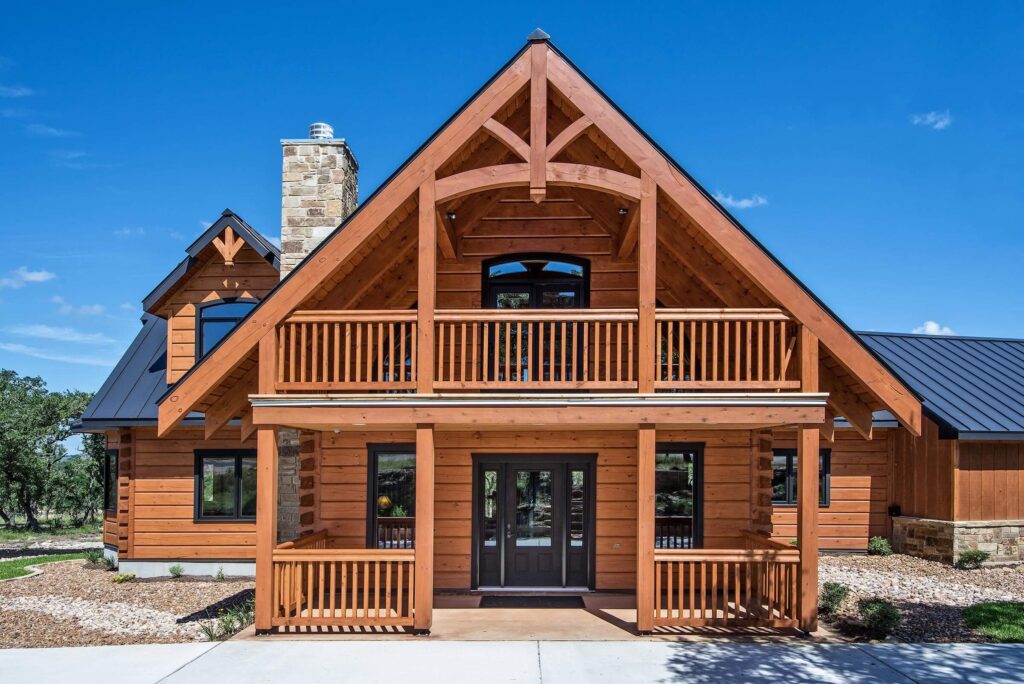
Frame houses - a budget-friendly option for wooden houses
Frame houses have become very popular in recent years due to their efficiency, affordability, and relatively simple construction technology. This type of wooden house is based on a wooden or metal frame, which is then filled with insulation material and covered both from the outside and inside.
The construction of a frame house includes the following main stages:
Foundation construction: Like other types of wooden house construction, the foundation plays a crucial role. However, frame houses often use lighter types of foundations, such as screw piles or strip foundations.
Frame assembly: Next, the frame is assembled, which consists of vertical posts and horizontal beams.
Insulation and cladding: After assembling the frame, an insulation layer is installed, and the house is clad from the outside and inside.
Now let’s consider the pros and cons of frame houses compared to other types of wooden houses.
Pros:
Construction speed: Thanks to pre-made elements and a simple construction technique, building a frame house takes significantly less time than constructing a log or timber house.
Energy efficiency: Frame houses retain heat well due to an effective insulation system.
Weight: Frame houses are much lighter, allowing the use of less expensive and complex foundations.
Cons:
Lifespan: The service life of a frame house is usually shorter than that of a log or timber house.
Sound insulation: Frame houses may have poorer sound insulation, especially when compared to log houses.
Aesthetics: If you prefer the traditional appearance of wooden houses with preserved wood texture, a frame house may not meet your aesthetic preferences.
In conclusion, frame houses are an excellent choice for those seeking a fast, energy-efficient, and budget-friendly way to build a wooden house. They are suitable for any climate and can be adapted to various architectural and design solutions.
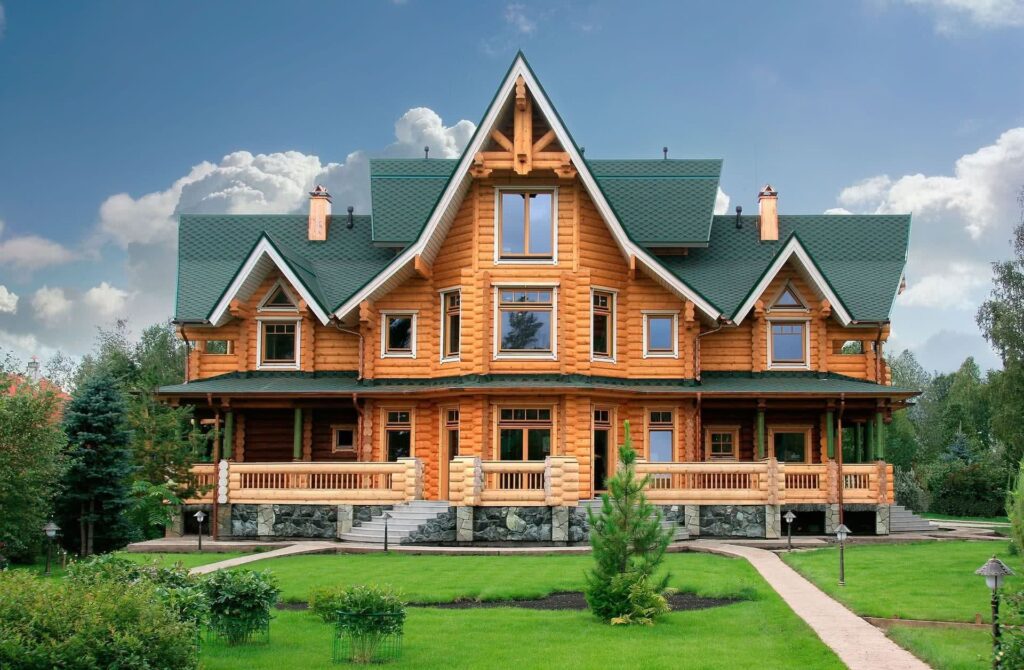
House made of profiled timber - a compromise between quality, price, and construction speed
Houses made of profiled timber are in high demand because they have some advantages over other types of wooden houses. Profiled timber is a type of processed wood that has undergone profiling to improve its properties and appearance.
The process of constructing a house from profiled timber includes the following stages:
Foundation preparation: Like with other wooden houses, the construction begins with preparing the foundation. In this case, strip, post, or screw pile foundations are suitable.
Timber installation: After preparing the foundation, the installation of profiled timber begins. Profiled timber already has special notches for connections, which simplifies the construction process.
Finishing and insulation: After erecting the walls, the finishing and insulation stage follows. Profiled timber already has a sufficiently smooth surface, which simplifies the finishing process.
Pros of houses made of profiled timber:
Construction speed: Thanks to ready-made elements and simplified construction technology, houses made of profiled timber are built faster than, for example, log houses.
Convenience in use: The timber is profiled in such a way that there are fewer gaps between its elements, which improves the thermal insulation properties of the house and makes it more comfortable to live in.
Appearance: Houses made of profiled timber have an attractive, neat appearance that combines modern and traditional elements.
Cons of houses made of profiled timber:
Price: The cost of profiled timber is usually higher than that of regular timber, which may affect the overall construction cost.
Additional treatment required: Despite being processed, the timber may require additional protection against moisture and pests.
Complexity of repairs: In case of damage to a timber element, its replacement may be more complicated and costly compared to logs or a frame.
In conclusion, houses made of profiled timber are an excellent compromise between construction speed, comfort, and appearance. They are suitable for those who seek a reliable and beautiful wooden house but do not want to wait too long for its construction.
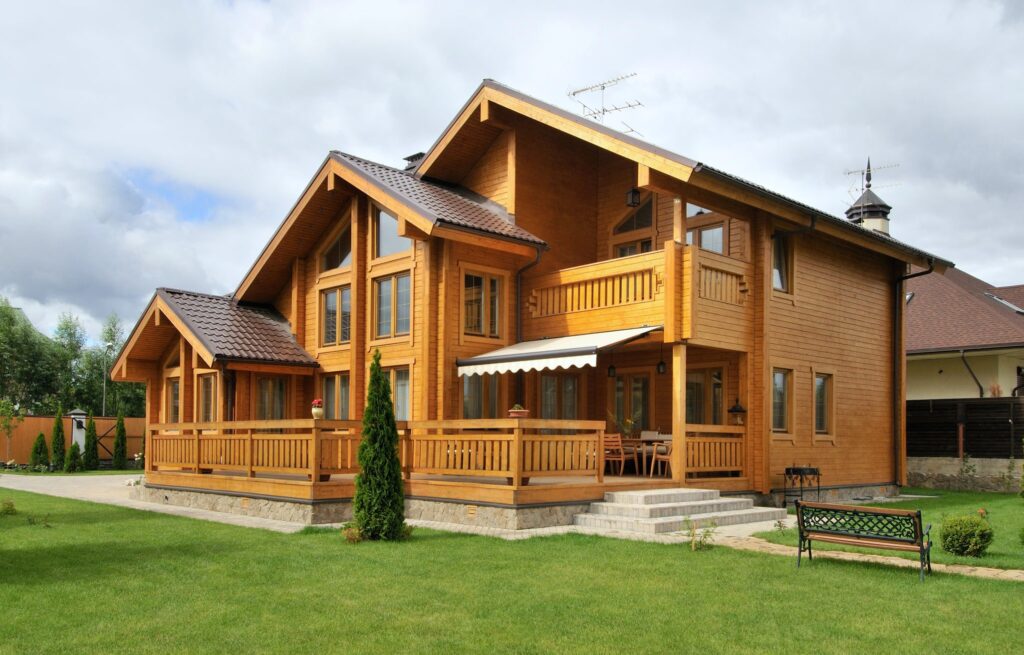
Conclusion on choosing wooden houses
In conclusion, all four types of wooden houses we discussed have their unique advantages and disadvantages.
Log houses are perfect for lovers of traditional architecture and natural materials. They have a unique atmosphere and charm but require more time for construction and careful maintenance.
Houses made of timber are a compromise between old and new technologies. They offer stable construction, good insulation, and relatively quick construction but may require additional protection against pests and weather conditions.
Frame houses are a modern and efficient solution for rapid house construction. They are lightweight, economical, and flexible in layout but may not provide the same level of “warmth” and aesthetics as log or timber houses.
Finally, houses made of profiled timber combine the best aspects of log and timber houses, offering stable construction, good insulation, and a pleasant appearance. They are suitable for those seeking a compromise between quality, price, and construction speed.
In the end, the choice of house type should be based on your personal preferences, budget, and construction conditions. Each of these types of houses can become a beautiful home for you and your family if you consider all factors and make the right choice.
